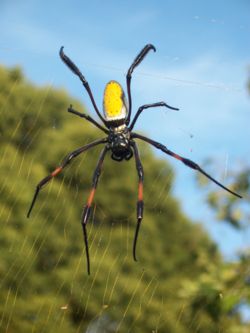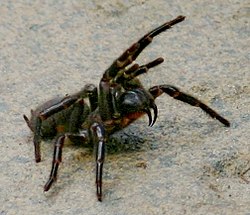| Araneomorph spiders Temporal range: | |
|---|---|
 | |
| Nephila inaurata (Nephilidae) | |
 | |
| Pholcus phalangioides female with eggsac ( Pholcidae ) | |
| Scientific classification | |
| Kingdom: | Animalia |
| Phylum: | Arthropoda |
| Subphylum: | Chelicerata |
| Class: | Arachnida |
| Order: | Araneae |
| Suborder: | Opisthothelae |
| Infraorder: | Araneomorphae |
| Subdivisions | |
| |
| Diversity | |
| 95 families | |
The Araneomorphae (also called the Labidognatha or "true spiders" [1] ) are an infraorder of spiders. They are distinguishable by chelicerae (fangs) that point diagonally forward and cross in a pinching action, in contrast to those of Mygalomorphae (tarantulas and their close kin), which point straight down. Araneomorphs comprise the vast majority (about 93% [2] ) of living spiders.


